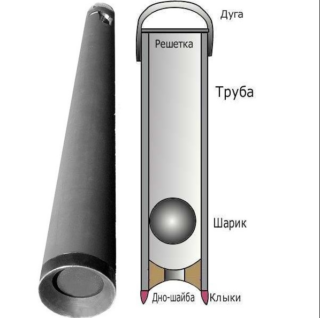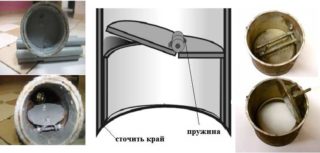In places where there is no centralized water supply, water wells are used. But they eventually deteriorate due to the accumulation of dirt and debris. To avoid this, a borehole cleaner is used.
What is a bailer for?

Wells go deep into the ground, so they are regularly clogged with dirt and debris. The frequency of using the bailer depends on many factors, which are determined by the region and the season: climate, weather conditions, type and quality of soil.
In dry climates, you can bore a well no more than once a year. In regions with frequent precipitation and a sharp change in temperature, it is advisable to use it for its intended purpose twice as often.
How the product works
The thief design consists of an all-metal pipe with thick walls, which on one side has an inlet valve - petal and in the form of a metal ball. On the reverse side, a cable or rope is attached, with the help of which the thief is removed from the hole after it is thrown there.
An optional but desirable structural element is the support to which the cable is attached. It prevents the bailer from falling into the hole and staying there. Depending on the complexity of the design, the support can have a whole system of one or more blocks through which the fastening thread is pulled. This principle makes it physically much easier for a person to retrieve the cleaning device from the well.
There are two valve options. The first is a metal sphere. It must be heavy, which means it must be solid and made of high-density materials. The diameter of the ball should be slightly less than the inner diameter of the pipe, but larger than that of the inlet, otherwise the sphere will fall out of the bailer. The second option is a metal plate attached to the end of the pipe so that it opens inward.
Principle of operation
The procedure to be followed to clean the well:
- The thief cable must be pulled through the blocks on the fastening structure in order to be able to conveniently lower and raise it. The length from the block system to the valve at the end of the pipe should be approximately one meter longer than the depth to the bottom of the well.
- When the preparatory work is completed, you need to direct the pipe into the hole, and then release it, sending it into free fall.
- The thief hits the bottom, and at this moment the valve opens, allowing water, dirt and debris, to enter the thief.
- A second after the impact, the ball or valve returns to its place and tightly plugs the inlet, thereby preventing the contents from getting out.
- The person pulls on the cable to lift the bailer and reach it to the surface.
- The contents are scooped out of the pipe through the opposite opening.
The procedure is repeated several times until the owner considers that the well is cleared of debris, or its remains can no longer be removed in this way.
Making a bailer

The bailer design consists of simple components that can be bought at the market or in a hardware store. To make it you will need:
- a pipe made of metal with high strength and density: steel, iron, cast iron;
- sheet metal;
- metal full-bodied ball;
- pipe adapter;
- steel cable or strong rope;
- welding machine;
- drill;
- block;
- steel beams.
The key to the effectiveness of using a thief for a well is its mass.The heavier the device, the more force the impact is on the bottom, which allows you to capture more debris at a time. Therefore, the walls of the thief pipe should be as thick as possible so that it weighs more. The same applies to the ball, since it acts not only as a valve, but also as a weighting agent. It can be turned on a machine, or a ready-made ball bearing can be used.
- Inside one side of the pipe, install an adapter with a hole with a smaller diameter than that of the main part of the structure.
- Weld the metal around the perimeter.
- If no adapter is available, sheet metal can be used instead. Cut a ring out of the sheet to fit the outer diameter of the pipe. It is important that the inner radius does not allow the ball to pass through it. Weld on the ring.
- At the opposite end of the thief, drill two holes in the walls, one opposite the other.
- Place the steel ball inside.
- Pull the cable through the holes and secure so that it cannot be pulled out. This can also be done with a welding machine.
- Take three steel beams and fasten them together so that you get a stable, even structure with three supports. Install it over the well. Then you need to install the block on the resulting mount.
- Stretch the cable.
- Gently lower the thief into the hole to check the depth.
It is recommended to stock up on a long cable so that later, if necessary, the excess can be cut off. When the parameters are selected, for reliability, you can also fix the second end on the supports.
After cleaning the well, the bailer must be returned to a serviceable state. Buy a metal brush with a long handle that matches the inside diameter of the pipe. Clean the thief after each use. This is done along the entire length with translational movements with scrolling. First you need to remove the ball and wash it in water. It is advisable to place the structure in a container with water for 2-3 hours so that the dirt will lag behind the walls.








